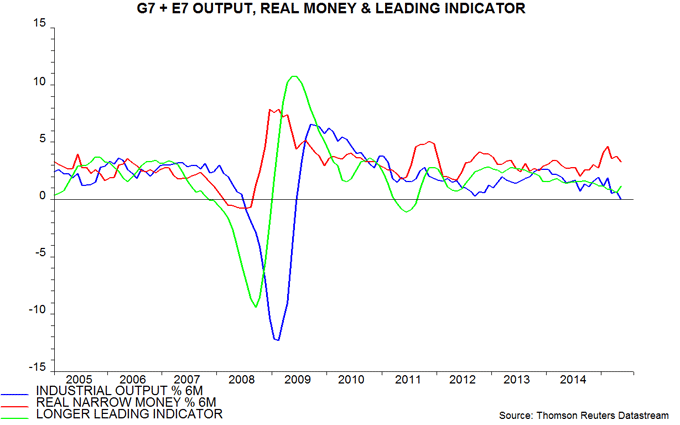Entries from July 5, 2015 - July 11, 2015
Global economic / liquidity backdrop benign, supporting equities
The MSCI All-Country World Index in US dollars was down by 6.5% from its 21 May all-time peak as of Wednesday, the recent low. The modest response to “Grexit” risk and Chinese stock market chaos is consistent with the assessment here of a supportive global economic / liquidity backdrop.
A post in February suggested that global economic growth would pull back into mid-2015 before strengthening in the second half of the year. The pull-back has been sharper than expected: six-month growth of industrial output in the G7 developed economies and seven large emerging economies (the “E7”) fell to zero in May – see chart.
The real or inflation-adjusted money stock leads the economy, typically by about nine months. The recent economic slowdown was signalled by a decline in six-month growth of G7 plus E7 real narrow money in the third quarter of 2014. Real money growth, however, rebounded in late 2014 / early 2015, suggesting stronger economic performance during the second half.
Other leading indicators have improved: a composite G7 plus E7 measure derived from the OECD’s country leading indicator indices recovered significantly in May (new OECD data were released this week). The lower oil price, meanwhile, may start to have a positive economic impact during the second half. An earlier post examined changes in global economic growth after five previous large oil price falls: there was no clear pattern after six months but growth was consistently higher a year later.
An important gauge of liquidity availability for markets is the gap between the growth rates of real money and industrial output. An investment strategy of buying world equities after this gap turns positive but moving to cash when it falls sharply or becomes negative would have outperformed buy and hold by 2.7% per annum over the last 45 years. Real money growth has moderated since February but a simultaneous economic slowdown has maintained a substantial “excess liquidity” cushion.
UK Budget: big changes, few winners
The big story of the Budget is a dramatic reduction in the squeeze on departmental spending. The Chancellor made room for less spending restraint by cutting deep into the welfare budget and raising taxes significantly. He also allowed his borrowing targets to slip again.
The fiscal stance over the next two years is less restrictive than projected in March. Cyclically-adjusted net borrowing falls by 2.1 percentage points (pp) of GDP between 2015-16 and 2017-18, down from 3.1 pp in March.
The Chancellor attempted to soften the welfare cuts by raising the personal allowance and introducing a compulsory “national living wage” for over 25s, targeted to reach £9.00 per hour by 2020 versus the current minimum wage of £6.50. The OBR expects little inflationary impact from this measure but admits to significant uncertainty.
The living wage announcement represents an attempt to shift some of the burden of welfare cuts onto the corporate sector. The OBR estimates a direct impact on corporate profits of almost £4 billion by 2020, which would outweigh the benefit of a lower corporation tax rate and other business “giveaways”. Firms also suffer a big hit over 2017-19 from an accelerated payment schedule.
Households are significant net losers too, with higher taxes on dividends, buy-to-let investors, pension contributions, insurance premiums and cars swamping the cost of increases in personal / inheritance tax allowances and a raised higher rate threshold.
Higher borrowing and the living wage may incline the MPC towards an earlier rate hike. With the burden on business rising, neither equities nor gilts have much to cheer.
Greece: latest thoughts
-
The comfortable “no” majority – the opposite result to that predicted by betting markets – will, at least, serve to accelerate the conclusion of the crisis.
-
The priority of the Eurozone authorities will shift from securing a deal with Greece to protecting other EMU members from financial contagion. This could involve an expansion of QE, a political commitment by leaders to implement the recommendations of the recent “five presidents’” report on strengthening monetary union, and financial guarantees against any ECB losses on its Greek exposure. Such measures would support markets.
-
The Eurozone authorities are very unlikely to agree a softer bail-out deal with up-front debt relief, as promised by PM Tsipras to his electorate. Without a deal, the ECB will be unable to maintain its current level of liquidity support to Greece without Eurozone guarantees against losses, let alone increase it. Banks will run out of cash in days, further increasing economic hardship. The government’s popularity may unravel swiftly, leading to new elections, perhaps triggered by the resignation of the president.
-
The liquidity crunch is likely to force the government to pay bills with scrip / IOUs, possibly as early as 12 July when public sector wages are due. These would trade at a large discount and their introduction could further undermine government popularity by raising fears of Grexit. Despite the “no” majority, polls indicate that support for the euro is at a record high.
-
The choice facing Mr Tsipras, therefore, is to accept a deal similar to the one he rejected 10 days ago or risk his popularity imploding along with the economy. Events are moving fast and a prolonged “Grimbo” – Greece remaining in the euro but with the banking system and economy in lockdown – is unlikely.
-
The suggestion here remains that wider market implications of the Greek crisis will be limited by a supportive global economic / liquidity backdrop and the determination of the Eurozone authorities to prevent contagion.

